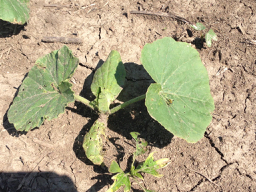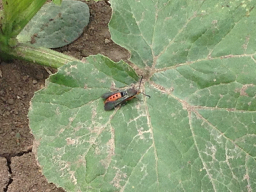By now, most pumpkin and squash growers have made it past the early season pests like cutworms and mice. Although cutworms show up only sporadically in cucurbits, they can cause lethal injury by cutting the stems of young pumpkin plants as they move off of weeds in the field, especially after a herbicide burn down. Field mice such as the white-footed mouse and the deer mouse, can also devastate plantings by digging up and eating seed, especially in no-till situations with a cover crop, such as winter rye. Once the seedlings have emerged, mice are rarely a threat.
Now that we are a little later in the season, we have other threats to be aware of, such as striped cucumber beetles and squash vine borer. Striped cucumber beetle adults can now be found congregating, sometimes en masse, on all types of cucurbits, including melons. The feeding damage can be severe enough to kill small seedlings, but just as important is the potential to spread bacterial wilt through wounds opened in the plant. Scout seedlings every few days, and if the threshold of beetles per plant is exceeded, then insecticide treatment is recommended. Take care to not spray insecticides when bees are active.
Thresholds are as follows:
Cotyledon-1st leaf, 0.5 beetles / plant
2nd-3rd leaf, 1 beetle / plant
4th leaf and older, 2 beetles / plant
The adult of squash vine borer, a purple and orange moth, is also now flying around looking to lay eggs at the base of zucchini, squash, and pumpkin plants. Losses to this pest are usually not severe in most commercial plantings, but home gardens can suffer greater losses. A pheromone trap can be used to determine if SVB is active in your area. If moths are captured, consider applying 2-4 sprays 7-10 days apart to control this pest with foliar insecticides directed at the base of the stem.
For the most current pesticide recommendations, consult the 2017 Midwest Vegetable Production Guide (https://ag.purdue.edu/btny/midwest-vegetable-guide/Pages/default.aspx).





I can say that mice are a pest late in the season. I am in Northern Illinois with pumpkins and spaghetti squash growing on arched trellises, 7 feet high at the center arch. Something has been eating both squashes; I thought it was squirrels because last year, when I was growing squash on the ground, there was confirmed squirrel feasting. Two nights ago, I went out with a flashlight to harvest some pumpkins. As I was cutting a pumpkin hanging from the top of an arch, I saw a mouse scurrying across the vines at the top of the arch. A good dousing of cayenne pepper works to protect squash. However, due to various squash positioning, I cannot sprinkle cayanne on every squash. I have lost an estimated 20% of my crop so far.